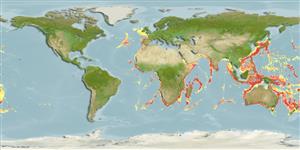>
Myctophiformes (Lanternfishes) >
Myctophidae (Lanternfishes) > Diaphinae
Etymology: Diaphus: Greek, dis, dia = through + Greek, physa, phyo = to beget, to have as offspring (Ref. 45335).
Eponymy: Shozaburo Watasé (1862–1929) was a biologist who became (1901) Professor of Zoology at the Imperial University of Tokyo, his alma mater. [...] (Ref. 128868), visit book page.
More on authors: Jordan & Starks.
Environment: milieu / climate zone / depth range / distribution range
Ökologie
seewasser benthopelagisch; tiefenbereich 100 - 2005 m (Ref. 27311). Subtropical
Indo-West Pacific: east African continental shelf south of about 2°S, west coast of Madagascar and off Japan. Also recorded from Indonesia and northwestern Australia (Ref. 5978). South China Sea and East China Sea (Ref.74511).
Length at first maturity / Size / Gewicht / Alter
Maturity: Lm 10.1 range ? - ? cm
Max length : 17.0 cm SL Männchen/unbestimmt; (Ref. 4066)
Rückenflossenstacheln (insgesamt) : 0; Rückenflossenweichstrahlen (insgesamt) : 14 - 15; Afterflossenstacheln: 0; Afterflossenweichstrahlen: 14 - 15.
Pseudoceanic, found over continental shelves and slopes (Ref. 4066). Mesopelagic species (Ref. 75154).
Hulley, P.A., 1986. Myctophidae. p. 282-321. In M.M. Smith and P.C. Heemstra (eds.) Smiths' sea fishes. Springer-Verlag, Berlin. (Ref. 4066)
IUCN Rote Liste Status (Ref. 130435: Version 2024-2)
Bedrohung für Menschen
Harmless
Nutzung durch Menschen
Tools
Zusatzinformationen
Download XML
Internet Quellen
Estimates based on models
Preferred temperature (Ref.
123201): 4.7 - 12.2, mean 7.9 °C (based on 759 cells).
Phylogenetic diversity index (Ref.
82804): PD
50 = 0.5000 [Uniqueness, from 0.5 = low to 2.0 = high].
Bayesian length-weight: a=0.00759 (0.00328 - 0.01756), b=3.02 (2.83 - 3.21), in cm total length, based on LWR estimates for this Genus-body shape (Ref.
93245).
Trophic level (Ref.
69278): 3.2 ±0.3 se; based on size and trophs of closest relatives
Widerstandsfähigkeit (Ref.
120179): mittel, Verdopplung der Population dauert 1,4 - 4,4 Jahre. (tmax=3.7; tm=1.4; K=0.8).
Fishing Vulnerability (Ref.
59153): Low vulnerability (17 of 100).
Nutrients (Ref.
124155): Calcium = 142 [54, 392] mg/100g; Iron = 1.32 [0.59, 3.33] mg/100g; Protein = 16.4 [14.4, 18.5] %; Omega3 = 0.955 [0.488, 1.812] g/100g; Selenium = 60.5 [22.5, 174.5] μg/100g; VitaminA = 32.2 [7.2, 182.9] μg/100g; Zinc = 0.986 [0.588, 1.591] mg/100g (wet weight); based on
nutrient studies.
